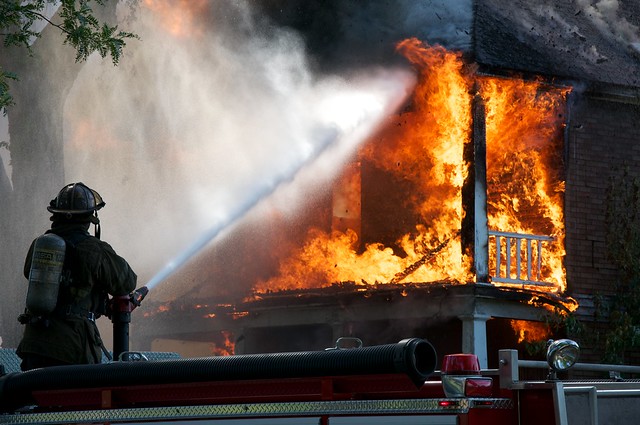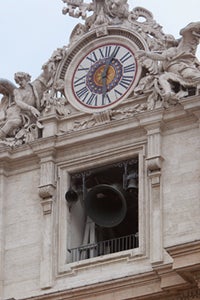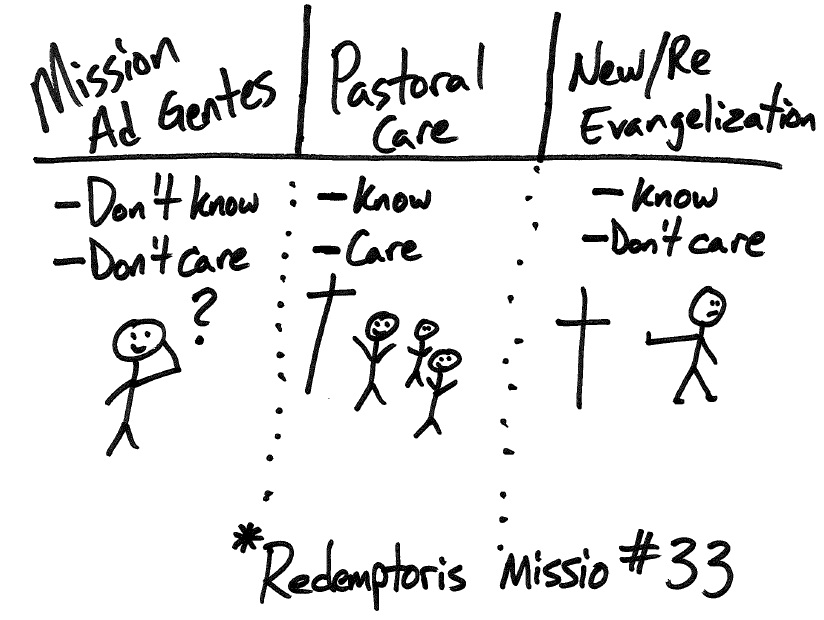Helping Catholic Parish Ministers unlock their ministry and defeat burnout forever. ❤️🔥
Is Christ Ugly?

Scars
Last summer I heard a Priest tell this story during his homily of a time he visited a sick man in the hospital. He went to the hospital multiple times and would sit and talk for an hour or so with the man to keep him company. In the room with this sick man was another man, a burn victim, who was severely disfigured from head to foot. Most of his face had been burned off. The Priest recounted how he tried to avoid looking at this burned man, because of how severely and grossly burned he was. One day, the sick man who the Priest was visiting asked the Priest if the burned man made him uncomfortable.
"You know," said the Priest, "I am ashamed to say it, but yes. I do not like looking at that man and his wounds are very disgusting."
"Would you like to know what happened to him?" asked the sick man. "Sure" replied the Priest.
"Him and his wife lived in a house nearby with their four children. One night the house caught fire and the whole family quickly ran outside to escape the fire. The father of the house gathered his family together in the front lawn, but noticed that their youngest daughter, only about two years old, was missing. Frantically, the father ran back into the burning house.
No one knew that the youngest daughter was in the house next door. When the fire started and everyone ran out the front door, the young girl went out the back door. The next door neighbor, wanting to protect the child and not seeing the rest of the family, brought the girl inside as she called 911.
The father, not finding the daughter, stayed in the house looking for her. And he stayed in there. And he stayed in there. And he stayed in there longer. Eventually the roof collapsed on top of him.
When the firefighters found him he was so badly burned they thought he was dead. The doctors said it was a miracle that he lived."

I Got a Picture of Jesus
The picture of Jesus above is also available as a poster, which hangs above my desk in my office. My office is in a middle school, so lots of kids pass by and see the image. I also use the image often with our high school youth group. The reactions it causes vary from a concerned "Wow" to straight up disgust. One day an adult came to meet me in my office and was causally talking until she noticed the image.
"So when are we going to get--OH! EW!"
There seems to have been a movement among Christians to remake Jesus as more human, accessible, and happy. The crucifixion, you could hear them say, is too ugly and inaccessible. It is too morbid and graphic and bloody and gross. Are they right?

Glorious Wounds of Love
I dare anyone to try to tell that young girl that her father's burn wounds are hideous and disgusting. After growing up and learning the significance of the scars, she will forever look upon her father and see not ugliness but the glory of a total and selfless love. The wounds have been incarnated into pure corporal love and self gift.
Why did Jesus' resurrected body still have the five wounds? Don't we receive a new, perfect body in the resurrection? Aren't wounds gross and disgusting, not worthy of a perfect, glorified, and heaven-bound body?

"The scars that remained in Christ’s body belong neither to corruption nor defect, but to the greater increase of glory, inasmuch as they are the trophies of His power; and a special comeliness will appear in the places scarred by the wounds... the greater beauty of glory compensates for all this, so that the body is not less entire, but more perfected." St. Thomas Aquinas (STh., III q.54 a.4)
Christ's crucifixion, and His wounds, might be disgusting on their own. But when you understand Jesus as a Father who runs into the burning house of our sin, and stays there until it attempts to destroy Him, the cross begins to look quite different. When I look at that poster of Jesus, I see this glorious love in those wounds. I see a God who felt the weight of my sins crash down on Him as He stayed there to save me.
Jesus' wounds and crucifixion are beautiful. In fact, they are the summit of all beauty; nothing could be more beautiful.
And maybe when we get to heaven God's martyrs will share in this transforming of wounds into glory and badges of love.
"Perhaps in that kingdom we shall see on the bodies of the Martyrs the traces of the wounds which they bore for Christ’s name: because it will not be a deformity, but a dignity in them; and a certain kind of beauty will shine in them, in the body, though not of the body." St. Augustine (De Civ. Dei XXII)
[youtube=http://youtu.be/CBWFzVfJ5-0]
Photo at top by Sam Beebe
Who are You Evangelizing?
The Church's deepest identity and reason for existence is to evangelize. (See Evangelii Nuntiandi par. 14) And Jesus commanded and commisioned all of us to "Go and make disciples of all nations". (Matt 28:19) But who are we called to evangelize? In the Church document "Mission of the Redeemer" (or Redemptoris Missio for you Latin lovers), Pope John Paul II points out three contexts in which the Church is called to evangelize.
According to Pope John Paul II, there are really only three types of people in the world:
1) Those who have never heard Christ or the Gospel. These people don't know about the Gospel, and therefore through no fault of their own they don't care about the Gospel. The missionary activity, or mission ad gentes of the Church is focused here.
2) Those who have heard the Gospel and are committed to Christian living and striving for holiness. These people know the Gospel and Christ and care about the Gospel and Christ. The pastoral activity of the Church is focused here.
3) Those who have heard about Christ and the Gospel to some extent, but have "lost a living sense of faith, or even no longer consider themselves members of the Church, and live a life far removed from Christ and his Gospel." The third context, as a kind of middle position between the previous two ends of the spectrum, consists of people who know the Gospel, or at least have come in contact with it to some extent. And, for some reason or another, they don't care about the Gospel they have been presented. They are the third generation Catholics in a postChristianity Europe and America whose parents only went to Mass on Christmas and Easter, and who become atheists or casual agnostics by the end of college. Or they are the children of ex-Catholics who are told that Catholics worship Mary and the Pope and don't believe the Bible.
What is required in this third case? "In this case what is needed is a 'new evangelization' or a 're-evangelization'". In this third case, a jarring from previously conceived notions is required. For this third case Christianity (or Catholicism) has been tried and found wanting, or so they think.
These activities of the Church's evangelization are related. "Each of them influences, stimulates and assists the others." (Redemptoris missio par. 34) But each context does require a different approach. Each type of person brings with them a different lens through which they see the Church and the Gospel and Christ. Some see Christ for the first time, others know Christ and need to better understand Him. Still others have rejected what they thought was Christ, or have intentionally rejected Christ whom they really did know. Each requires different sensitivities, approaches, and methods.
Whether we are Catholic writers or speakers or missionaries or Priests or Mothers or lawyers or businessmen, the question we should all be asking ourselves when we attempt to participate in the Church's call to evangelize is:
Who are we evangelizing?
Redemptoris missio Paragraph #33
The fact that there is a diversity of activities in the Church's one mission is not intrinsic to that mission, but arises from the variety of circumstances in which that mission is carried out. Looking at today's world from the viewppoint of evangelization, we can distinguish three situations.
First, there is the situation which the Church's missionary activity addresses: peoples, groups, and socio-cultural contexts in which Christ and his Gospel are not known, or which lack Christian communities sufficiently mature to be able to incarnate the faith in their own environment and proclaim it to other groups. This is mission ad gentes in the proper sense of the term.
Secondly, there are Christian communities with adequate and solid ecclesial structures. They are fervent in their faith and in Christian living. They bear witness to the Gospel in their surroundings and have a sense of commitment to the universal mission. In these communities the Church carries out her activity and pastoral care.
Thirdly, there is an intermediate situation, particularly in countries with ancient Christian roots, and occasionally in the younger Churches as well, where entire groups of the baptized have lost a living sense of the faith, or even no longer consider themselves members of the Church, and live a life far removed from Christ and his Gospel. In this case what is needed is a "new evangelization" or a "re-evangelization."
“Say What?” Monday Catechism Series #8 - Sacred Heart of Jesus
 A new series on this blog. Each Monday I’ll be posting a gem from our Catechism of the Catholic Church that is interesting or remarkable.
A new series on this blog. Each Monday I’ll be posting a gem from our Catechism of the Catholic Church that is interesting or remarkable.
This week's interesting catechism is about the Sacred Heart of Jesus.
478 Jesus knew and loved us each and all during his life, his agony and his Passion, and gave himself up for each one of us: "The Son of God. . . loved me and gave himself for me." He has loved us all with a human heart. For this reason, the Sacred Heart of Jesus, pierced by our sins and for our salvation, "is quite rightly considered the chief sign and symbol of that. . . love with which the divine Redeemer continually loves the eternal Father and all human beings" without exception.
+JMJ
_________________________________________________________________
Like this Series? Subscribe here to get it in your email and you’ll never miss any Catholic goodness from this blog! Do it here!
Bob Rice: "How the Catechism Made Me Catholic"
 Here is a witness from Bob Rice about how his life was changed by reading and praying through the Catechism of the Catholic Church.
Here is a witness from Bob Rice about how his life was changed by reading and praying through the Catechism of the Catholic Church.
"I remember looking down and seeing blood on my hands. My head was still spinning from the line of cocaine that I snorted in the bathroom. The prostitute I just had sex with was face down on the bed, murdered. Did I do it? I couldn’t remember. I heard sirens outside and footsteps running up the stairs to my apartment. That was the moment that I realized I needed a Savior. I needed Jesus.
Okay, none of that is true."

"Truth be told, I have a very boring conversion story: I always loved Jesus. And then I loved Him more.
I was the good kid. Never drank. Never did drugs. Knew to save sex for marriage. In fact, I lived in fear of letting others down: my parents, my teachers, or even God. I was a straight A student and prayed every night.
So it might not be a surprise when I tell you that one of the most exciting moments in my conversion is when I did something that many consider boring:
I read the Catechism."
-->Read the rest of the article here, and then go read the Catechism.<--
Two practical takeaways from his post:
+ If the Catechism seems overwhelming, try committing to reading one "In Brief" summary at the end of each section in the Catechism every day.
+ If you need an easy place to start, the fourth pillar of the Catechism on prayer is a good place.
_________________________________________________________________
Bob was my professor for many many classes while I attended Franciscan University, and I have to thank him for forming me as a Catholic, catechist, and youth minister, (and actually as a father too) through his deep love for Jesus, his witness as a father, and his love for the Catholic Church. Maybe one day I will write a post about all the ways he has so tremendously impacted me, but it would be too sappy.
Thanks Bob.
The Mass: A Model for Personal Prayer
 St. John of the Cross Statue by Magdeleine Weerts
St. John of the Cross Statue by Magdeleine Weerts
What should the rhythm of our personal prayer look like? Is prayer just one action, or a movement toward God with a beginning, middle, and end? The Church gives us an answer in the Catechism of the Catholic Church. This rhythm is akin to the Mass and can help us enter into prayer more easily and develop a habit of prayer that moves us towards God.
Personal Prayer and the Mass
If we look in the fourth pillar of the Catechism on prayer (remember, the Catechism is split into four pillars - Creed, Sacraments, Morality, and Prayer) especially the section on contemplative prayer, the Catechism makes the connection between contemplative prayer and the Mass:
"Entering into contemplative prayer is like entering into the Eucharistic liturgy" (paragraph 2711).

Remember, contemplative prayer is not something only reserved for Nuns or levitating Saints, contemplative prayer is nothing more than "a close sharing between friends" and "a gaze of faith, fixed on Jesus" meant for every Christian.
As we'll see in the Catechism, there are four movements to this rhythm of prayer: GATHER, RECOLLECT, ABIDE, ENTER.
Let's unpack the rest of paragraph 2711 to find a rhythm of personal prayer and its connections to the Holy Sacrifice of the Mass.
GATHER

"Entering into contemplative prayer is like entering into the Eucharistic liturgy: we "gather up" the heart, recollect our whole being under the prompting of the Holy Spirit, abide in the dwelling place of the Lord which we are, awaken our faith in order to enter into the presence of him who awaits us." CCC 2711 __________________________________________________________________________
At the beginning of Mass, we begin with the sign of the Cross and with an opening prayer, called the Collect. Thus the beginning of Mass is a call to gather ourselves up from the world and reorientate ourselves in relation to Christ.
When I first walk into Mass, there are a thousand thoughts and distractions going through my head, as when I first begin to pray. At the beginning of prayer and the Mass, the first step is gathering our attention and thoughts and disengaging from the world around us (like Kevin Costner in that baseball movie...) so that we can place ourselves in the presence of God. Making the Sign of the Cross is a good way to begin prayer because it reminds us why we pray and to whom we pray.
St. Francis de Sales offers four ways of disengaging from the world and placing ourselves in the presence of God in the Introduction to the Devout Life:
1) Realizing God is omnipresent; that God is in everything and everywhere 2) Realizing God is in a very special manner in your heart and the depth of your spirit 3) Realizing God looks down on us from heaven, especially those in prayer 4) Imagining Jesus Christ in his humanity as though he were near us or next to us
RECOLLECT

"Entering into contemplative prayer is like entering into the Eucharistic liturgy: we "gather up" the heart, recollect our whole being under the prompting of the Holy Spirit, abide in the dwelling place of the Lord which we are, awaken our faith in order to enter into the presence of him who awaits us." CCC 2711 _________________________________________________________________________
At the beginning of Mass after the opening prayer is the Penitential Rite, where we acknowledge our sins and repent of them, followed by the Gloria praising God for his mercy and love.
Likewise the next phase of prayer means being honest with ourselves and with God about the state of our our soul and our heart. "We do not know how to pray as we ought" (Romans 8:26), but if we ask, the Holy Spirit teaches and guides us in prayer to acknowledge and relate to God truthfully who we are, where we have been, our thoughts, desires, baggage, and even our recent sins and shortcomings.
A few paragraphs back, the Catechism explains contemplative prayer in the words of St. Teresa: "Conteplative prayer in my opinion is nothing else than a close sharing between friends" (Catechism 2709). It's like answering the question "How ya' doing?" from a friend you haven't seen in awhile.
ABIDE

"Entering into contemplative prayer is like entering into the Eucharistic liturgy: we "gather up" the heart, recollect our whole being under the prompting of the Holy Spirit, abide in the dwelling place of the Lord which we are, awaken our faith in order to enter into the presence of him who awaits us." CCC 2711 __________________________________________________________________________
During Mass, we abide in the presence of God and listen to Him. We hear His voice in the Old Testament, His glory in the Psalms, and encounter Him in the flesh in the Gospels, all during the Liturgy of the Word.
After coming to God in prayer and talking to Him about what is honestly going on in our heart and in our lives, the conversation begins to turn over to God. Just like on the road to Emmaus (Luke 24:13-35), after we unload what is on our hearts we give God the opportunity to respond to us. This is when true contemplative prayer can begin.
In the following paragraphs of the Catechism, it explains that "contemplative prayer is hearing the Word of God." (Catechism 2716) In order for us to hear the Lord, we need to be patient and wait on Him (Psalm 27:14). I can't stress enough how important interior silence is for prayer. How can we hear God speak to us if we never shut up? Don't be afraid that you are doing nothing by sitting in silence this way. "Contemplation is a gaze of faith, fixed on Jesus." (Catechism 2715). As long as you are focused on God, you are praying. Sometimes God speaks words to your heart, sometimes He sends you peace, sometimes He may just be present with you in that moment, pouring out His love on you.
ENTER

"Entering into contemplative prayer is like entering into the Eucharistic liturgy: we "gather up" the heart, recollect our whole being under the prompting of the Holy Spirit, abide in the dwelling place of the Lord which we are, awaken our faith in order to enter into the presence of him who awaits us." CCC 2711 __________________________________________________________________________
The most intimate moment of Mass happens when we receive our Lord in the Eucharist and come into communion with our God.
Contemplative prayer is a gift beyond words. Initiated by God, we become caught up in the life of the Trinity and are led to share in the love between the Father and the Son. There is no way to make this happen, we must abide in God's presence and wait for Him to bring us into communion with Him. But when this gift does occur, when God allows us to enter into His mystery and experience a foretaste of heaven, it is like an blaze of faith, hope, and love being ignited in your chest!
It's That Easy! (Sort of)
Prayer is hard work, especially contemplative prayer. Remember, God is the one who initiates contemplative prayer, it is a gift and we can only patiently wait with a loving gaze fixed on Him. Realize that it will be hard at the beginning, but if we put in even the smallest effort to reach out to God in love, God graciously reward us. Set up a time to regularly practice praying in this way everyday and you will begin to experience the deep love, joy, and peace of a life in intimate relationship with God.
A Rhythm of Prayer from Catechism 2711 "Entering into contemplative prayer is like entering into the Eucharistic liturgy: we "GATHER up" the heart, RECOLLECT our whole being under the prompting of the Holy Spirit, ABIDE in the dwelling place of the Lord which we are, awaken our faith in order to ENTER into the presence of him who awaits us. We let our masks fall and turn our hearts back to the Lord who loves us, so as to hand ourselves over to him as an offering to be purified and transformed."
+JMJ
###What do you think? Was this helpful? Let me know in the comment box. God Bless!
Dr. Brant Pitre Talk on the Jewish Roots of the Eucharist
[youtube=http://www.youtube.com/watch?v=NYDSPcEoC74]
How would ancient Jews have understood the Eucharist?
This mind blowing talk by Dr. Brant Pitre on the Jewish roots of the Eucharist answers that question. Prepare to have your little Catholic brain explode - you'll never look at the Eucharist the same again.
Just a little teaser for you as I read and write a super-review of his book "Jesus and the Jewish Roots of the Eucharist".
Dual Wielding the Bible and the Catechism
If you want to be a good Catholic, you gotta read your Bible. But the Church advises us: "sacred tradition, Sacred Scripture and the teaching authority of the Church... are so linked and joined together that one cannot stand without the others" (Dei Verbum Par. 10).
Combining Sacred Scripture and Sacred Tradition is a deeply Catholic way to read the Bible, and a powerful way to dive deep into our Faith. If Sacred Scripture and Sacred Tradition are so intimately linked, reading them in light of one another is drinking deeply from the wells of faith the Church has to offer. (What a great idea for the Year of Faith!!!)
But how can we do this easily and effectively?
The following is a method of doing just that. I'll be walking you through how to break open Scripture with the eyes of the Church using the catechism and its index of citations (mentioned in the post how to use the catechism). So grab The Word and a catechism and let the dual wielding begin...
The Bible
The Gospel reading a few days ago is taken from Luke 19:1-10 (read it online here) and recounts the story of the meeting of Jesus and Zacchaeus, the tax collector. Zacchaeus hears Jesus is coming to Jericho and "was seeking to see who Jesus was". Being a short fellow (for some reason I picture him as Danny Davito) Zacchaeus climbs a tree to get a glimpse of Jesus. As Jesus passes by he calls out to the man in the tree, announcing he will stay at Zacchaeus' house. Zacchaeus comes "down quickly and received him with joy". The now repentant tax collector vows to give half his possessions to the poor and to repay those he has wronged four times over. Jesus concludes "Today salvation has come to this house because this man too is a descendant of Abraham. For the Son of Man has come to seek and to save what was lost.”
Reading this passage, there are a few questions that come to mind. What does it mean for Zacchaeus that Jesus wants to stay at his house? And why does Zacchaeus have such a strong reaction to Jesus? It seems there are some things going on here that might not be obvious to us.
The Catechism
Using the index of citations at the back of the catechism we can look up where in the sections of the catechism this episode with Jesus and Zecchaeus is cited.
If you can't find the index of citations, look for the last paragraph of the catechism, 2865. It is right after it.
There are four citations of this passage throughout the catechism. One references the entire passage of Luke 19:1-10, and the other three reference two lines from this passage. The catechism cites all of Luke 19:1-10 in paragraph 2712, so let's start there to see how the Catechism uses this passage to explain the faith to us.

Catechism #2712 "Contemplative prayer is the prayer of the child of God, of the forgiven sinner who agrees to welcome the love by which he is loved and who wants to respond to it by loving even more. (Luke 19:1-10) But he knows that the love he is returning is poured out by the Spirit in his heart, for everything is grace from God. Contemplative prayer is the poor and humble surrender to the loving will of the Father in ever deeper union with his beloved Son."
Contemplative prayer? What is going on here? At first glance I was thoroughly confused too. But confusion is a good thing. Confusion means we don't understand, which means we could be staring at an opportunity to learn. If you only ever read what you understand you may gain information, but you will never gain understanding.
Sweet Symphony
So how does the catechism help us understand the story of Zacchaeus better? Let's look at three of the catechism paragraphs that cite this passage and see if we can make some better sense of what is going on.
If we read through paragraph 2712 it is clear that Zacchaeus is "the forgiven sinner who agrees to welcome the love by which he is loved". The love by which Zacchaeus is loved is Jesus, who desires to stay with Zacchaeus.
We can look to catechism paragraph 1443 which explains that Jesus "not only forgave sins, but also made plain the effect of this forgiveness: he reintegrated forgiven sinners into the community of the People of God from which sin has alienated or even excluded them."
So Zacchaeus, the tax collector, was a man probably alienated from the community of the People of God because of his sins. But how is staying at someone's house a great act of love on Jesus' part?
If we continue reading we find the answer. Jesus is offering Zacchaeus an act of reconcilliation by offering to not just stay with him, but to dine with him: "Jesus receives sinners at his table, a gesture that expresses in an astonishing way both God's forgiveness and the return to the bosom of the People of God."
We can even see that Zacchaeus' strong reaction is a just action. In paragraph 2412 the catechism explains: "Jesus blesses Zacchaeus for his pledge: 'If I have defrauded anyone of anything, I restore it fourfold." Those who, directly or indirectly, have taken possession of the goods of another, are obliged to make restitution of them, or to return the equivalent in kind or in money...".
Wrapping It Up
These three paragraphs from the catechism shed some light on the story of Zacchaeus and Jesus.
By offering to dine at the table of Zacchaeus (Catechism 1443), Jesus gives Zacchaeus an opportunity to be reconciled with God and brought back into the community of the People of God.
Zacchaeus is not just showboating when he vows to give to the poor and repay those he has wronged. He is being offered love by Jesus and is so overwhelmed by what is being offered to him that he desires to respond to it by loving even more (Catechism 2712). This is an model of the dynamics of prayer.
Not only does Zacchaeus reconcile with those he has wronged, he goes above and beyond the demands of justice (Catechism 2412) and pledges to repay his debtors fourfold and to give half of his possessions to the poor.
Prayer
After reading this passage in Scripture and the paragraphs in the catechism, some things about prayer really started to click. Prayer is a response of love to God. In prayer we begin by realizing how much love the Father has for us, to take notice of us and offer us reconciliation like Jesus offered Zacchaeus. And we respond "quickly and [receive] him with joy", being given a child-like desire from the Holy Spirit. We begin to desire the impossible - to love God even more than He loves us.
And not only do we enjoy the love of God, and enjoy giving love back to him but, like Zacchaeus, it then spills over into our life with our neighbors. After experiencing such a deep and forgiving love, I am compelled to reconcile with my neighbors.
Reading Scripture with the catechism gave me a profound insight into the life of prayer and relationship with God. I am sure this image of Zacchaeus' impossible thankfulness and surge of the heart will be in my mind every time I pray for the next few months.
CHALLENGE
I want you to try praying with Scripture and the catechism this way. All you need is twenty minutes, a Bible, and a catechism for an intense prayer time dual wielding Sacred Scripture and Sacred Tradition.
Step 1) Go somewhere you can pray. Bring a Bible and a Catechism.
Step 2) Take a passage from Scripture, or even just one line from Scripture, and look it up in the index of citations in the catechism.
Step 3) Prayerfully read through all the referenced passages. If there are too many, then either narrow down the Scripture or focus on any references in the catechism to the passage that don't make sense right away. Prayerfully reread them and ask God to teach you.
Step 4) Let me know in the comment box (or on your own blog!) your experience or what God revealed to you by praying Scripture with the catechism this way.
Some Passages to Try
I haven't tried these passages, but I would love to in the future. If you can't think of a place to start, start with these.
John 6:54 Luke 1:37 Jeremiah 31:31-34 Genesis 3:15 Luke 3:21 Isaiah 43:1-7
#### I challenge you to try praying with Scripture and the catechism this way. Follow the steps and leave a comment telling me how it went. If you have any hang ups, let me know and I'll try to help.
+JMJ
"Say What?" Monday Catechism Series #2
 A new series on this blog. Each Monday I'll be posting a gem from our Catechism of the Catholic Church that is interesting or remarkable.
This week's Interesting Catechism concerns faith and science. Are the two in opposition? Are faith and reason contradictory?
A new series on this blog. Each Monday I'll be posting a gem from our Catechism of the Catholic Church that is interesting or remarkable.
This week's Interesting Catechism concerns faith and science. Are the two in opposition? Are faith and reason contradictory?
159 Faith and science: "Though faith is above reason, there can never be any real discrepancy between faith and reason. Since the same God who reveals mysteries and infuses faith has bestowed the light of reason on the human mind, God cannot deny himself, nor can truth ever contradict truth." "Consequently, methodical research in all branches of knowledge, provided it is carried out in a truly scientific manner and does not override moral laws, can never conflict with the faith, because the things of the world and the things of faith derive from the same God. The humble and persevering investigator of the secrets of nature is being led, as it were, by the hand of God in spite of himself, for it is God, the conserver of all things, who made them what they are."
+JMJ
___________________________________________________________________________
Like this Series? Subscribe here to get it in your email and you'll never miss any Catholic goodness from this blog! Do it here!
"Say What?" Monday Catechism Series #1
 Introducing a new series on this blog: each Monday I'll be posting a gem from our Catechism of the Catholic Church that is interesting or remarkable.
This week's Interesting Catechism is about discrimination against those with homosexual tendencies. It may come as a shocker, but the Church actually does believe that homosexuals should be accepted and loved. But this paragraph is followed by another that explains that acceptance does not mean honoring or promoting same-sex marriage, nor is the Church saying that those with homosexual tendencies should act on them. Persons with homosexual tendencies are called to chastity and Christian perfection.
Introducing a new series on this blog: each Monday I'll be posting a gem from our Catechism of the Catholic Church that is interesting or remarkable.
This week's Interesting Catechism is about discrimination against those with homosexual tendencies. It may come as a shocker, but the Church actually does believe that homosexuals should be accepted and loved. But this paragraph is followed by another that explains that acceptance does not mean honoring or promoting same-sex marriage, nor is the Church saying that those with homosexual tendencies should act on them. Persons with homosexual tendencies are called to chastity and Christian perfection.
2358 The number of men and women who have deep-seated homosexual tendencies is not negligible. This inclination, which is objectively disordered, constitutes for most of them a trial. They must be accepted with respect, compassion, and sensitivity. Every sign of unjust discrimination in their regard should be avoided. These persons are called to fulfill God's will in their lives and, if they are Christians, to unite to the sacrifice of the Lord's Cross the difficulties they may encounter from their condition.
2359 Homosexual persons are called to chastity. By the virtues of self-mastery that teach them inner freedom, at times by the support of disinterested friendship, by prayer and sacramental grace, they can and should gradually and resolutely approach Christian perfection.
+JMJ
___________________________________________________________________________
Like this Series? Subscribe here to get it in your email and you'll never miss any Catholic goodness from this blog! Do it here!
Does Jesus Hate Tattoos?
 Check out this great article on tattoo taboos, Leviticus, and the tattoo on Jesus' thigh by the world renowned Nate Addington.
Check out this great article on tattoo taboos, Leviticus, and the tattoo on Jesus' thigh by the world renowned Nate Addington.
"Every so often someone, usually of the elderly female variety, will raise one of three standard objections to tattoos.
1.) Someday you are going to regret that
2.) When you are old those are going to look horrible
and of course
3.) You know God does not like tattoos, it just isn’t Christian.
To which I always respond that I have never regretted, even for a fraction of a millisecond, any of my tattoos. Furthermore, when I am old and orchestrating wheelchair street races in the local nursing home, me and all my geriatric buddies will stretch out our wrinkled skin, take a shot of our prune juice, and share the stories of our tattoos while reminiscing about the good ole’ days when we were young and gas was only $4.00 a gallon."








